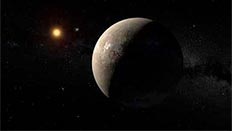Resources
Explore independently
A wealth of resources exist online for those who wish to find them. The University of Hertfordshire is committed to contributing towards these and we continue to create more resources to help further the understanding of students, teachers and enthusiasts. A number of these resources are listed below.
-
Habitability
Brunometer
A Brunometer is a free, hand-held mechanical device that you can make yourself out of card and acetate. Once assembled, the device can be used to calculate the surface temperature of an exoplanet with defined properties.
Binary simulator
This Excel based simulator allows you to visualise the path of a planet orbiting in a binary star system. The temperature of the planet is calculated and plotted throughout the duration of the orbit, allowing you to determine whether water can permanently exist in liquid form on its surface.
-
Find a transit
Kepler
Explore the data recorded by Kepler, science's most prolific planet hunter. Search for a specific star in the target box and you may be able to view light curve data for it covering many years. The second stage of the mission, K2, has a similar search page and can be used in the same way.
Transit Follow-up Tool
Hoping to view a transit tonight? The transit follow-up tool allows users to create predicted light curves for transits and discover when the next visible transits will occur. These predictions enable anyone with suitable equipment the opportunity to measure transits.
-
Determine orbits
Create Periodograms
'Periodograms' help users to find periods in data by trialling many different periods and determining how 'good' a fit each period provides. Systemic Live offers this feature. Use their tutorial to rediscover one of the first exoplanets ever detected! Alternatively, Agatha offers the ability to upload your own data and plot different types of periodogram. A worked example using Agatha is provided in our guide (PDF - 2.2 Mb).
NASA Exoplanet Archive
This archive, in addition to holding a comprehensive list of all exoplanets, also contains many features such as the ability to create periodograms for the data. This is relatively user friendly and can be handled solely online.
-
Compilation of exoplanets
Exoplanet catalogues
Browse the lists to compare how widely exoplanets vary in terms of their mass, size and orbital period. See exoplanet.eu, exoplanets.org and the NASA Exoplanet Archive for details.
Simbad
If you are looking to investigate a specific star or planet, Simbad holds a wealth of information. Very importantly, it tells you the many different names a star is known by. It may be important to search for these various names in literature when looking for existing information about a particular star.
-
Find a paper
Astrophysics Data System
ADS allows you to search for research papers referring to a specific star or planet with ease. In addition to searching the object name, you can also include key words that you require to appear in the paper. ADS will then rank the search results in the order they best match your search criteria.
Exoplanet.eu
Papers relevant to specific planets can be found by clicking on them within the catalog search engine. Additional search methods can by found in the bibliography page, where the option is given to search through publications, books, theses and reports.

